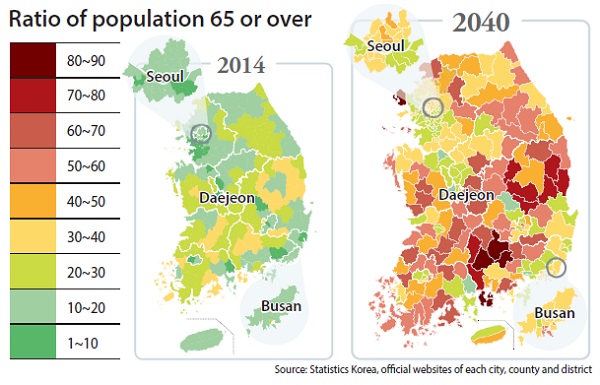By 2040, some spots will be older than others

“Explaining the functions of a cellphone as easily as possible is the key to this business,” Kim said. “I have to explain to customers how to actually work a smartphone and the details of the calling plan they may choose.”
Namgajwa 1-dong has the fifth-highest senior population rate in Seoul, with approximately one out of every five residents (703 out of 3,718 people, or 18.7 percent) aged 65 or older, according to data provided by Statistics Korea. That’s higher than the national average of 12.7 percent. The four neighborhoods in Seoul with higher rates are Euljiro-dong, Jongno District, Samcheong-dong and Hoehyeon-dong.
Forty percent of Namgajwa 1-dong’s population is between the ages of 40 and 64.
“My clientele are senior citizens, so I tend to stack a lot of pain relief patches, digestive medicine and cheongsimhwan,” said a pharmacist who has worked in Namgajwa 1-dong for the past five years. Cheongsimhwan is a traditional Korean herbal medicine that is believed to reduce anxiety.
With recent studies indicating Korea is on a fast track to becoming an aged society, signs of the demographic shift are already evident throughout the country, with local pundits claiming a bad scenario is just around the corner.
Recent data jointly compiled by Statistics Korea and the JoongAng Ilbo, an affiliate of the Korea JoongAng Daily, shows that 72 of the country’s 252 cities, counties and districts (28 percent) will have a population of which over half is aged 65 or older by 2040. Namhae County, Hapcheon County and Uiryeong County, all in South Gyeongsang, will see their rates exceed 80 percent.
Korea is currently categorized as an aging society, meaning that more than 7 percent of the country’s total population is 65 or older. The country is set to become an aged society by 2026, when more than 14 percent of the entire population will be 65 or older.
“Korea is destined to embrace an aged population,” said Jeong Gyeong-hee, who researches aging demographics at the Korea Institute for Health and Social Affairs. “In order to alleviate that shock, the country has to drastically raise the birthrate by expanding welfare services related to having children.”
Predictions set out for 2040, based on the aforementioned study conducted by the JoongAng Ilbo and Statistics Korea, reveals that largely rural South Gyeongsang will have the most aged communities among the eight provinces, with six places ranking within the country’s top 10.
Among areas near Seoul, where populations are generally young, Ganghwa County in Incheon is expected to see the highest rate of residents aged 65 or older, with 82.7 percent. In Seoul, some 30 percent of the population will be in that age group, in contrast to 12 percent from 2014.
Areas with the smallest rates of senior citizens in 2040 will likely be Seongsan District in Changwon, South Gyeongsang (13.1 percent); Yeongtong District in Suwon, Gyeonggi (14.7 percent); Gumi, North Gyeongsang (15.6 percent); Seobuk District in Cheonan, South Chungcheong (15.8 percent); and Gwangyang, South Jeolla (19.5 percent).
“In the past, you had to actually go to the suburbs in order to see old people,” said Kim Mun-jo, a sociology professor at Korea University. “Now, a lot of that is changing. Like Tokyo, Korea’s urban areas will be flooded with elders, and rural areas will just disappear.”
According to a study conducted by Yun Jeong-mi, a researcher with the ChungNam Institute, 351 villages in South Chungcheong will vanish by 2040 after reaching zero population. Yun’s definition of a village was an area smaller than Korea’s administrative division of a ri, which is composed of 50 residents or less.
One village named Beomjikyi currently has merely five households, four of which are composed of residents aged 70 or over. Kim Yong-man, the 58-year-old leader of the village, says he’s so relatively “young” that he runs all the errands for his neighbors.
“Elders living in the suburbs tend to bond among each other,” said Jeong Gyeong-hee from the Korea Institute for Health and Social Affairs. “But life in the city is nothing like that, so old people who live in high-rise apartment complexes will more likely develop a sense of alienation. [Regional governments] must come up with community services to bring those people together.”
BY SOHN GUK-HEE, PARK BYEONG-HYUN, YU SEONG-UN [lee.sungeun@joongang.co.kr]










with the Korea JoongAng Daily
To write comments, please log in to one of the accounts.
Standards Board Policy (0/250자)